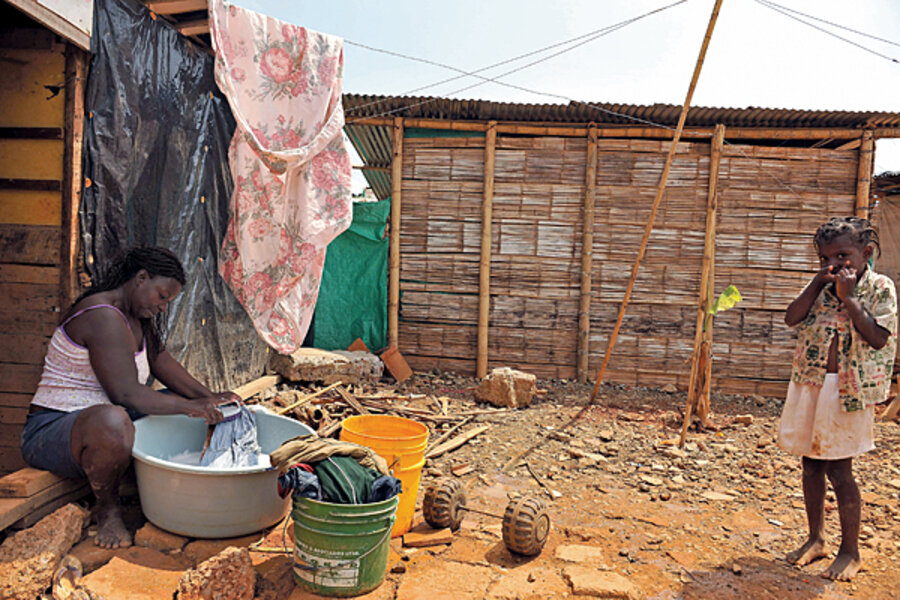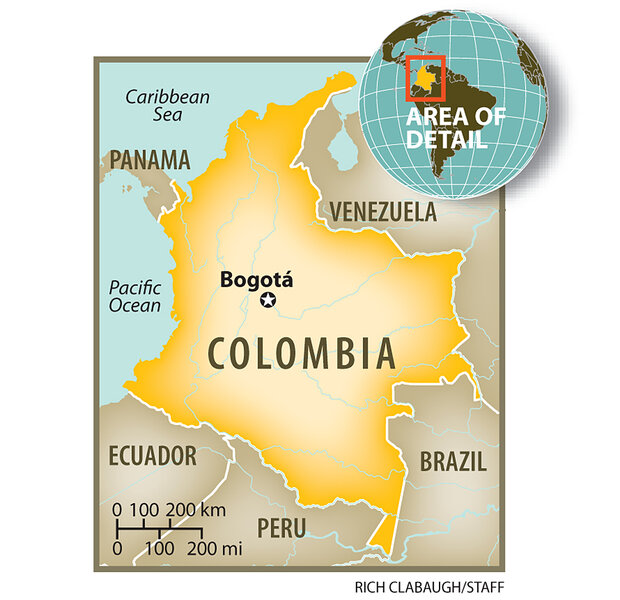How Colombia's President Santos aims to tackle decades of violent land disputes
Loading...
| San Onofre, Colombia
Colombia has tried this before.
In 1968, the government encouraged peasants to take over fallow land. This spurred Manuel Aguas, once a stableboy who grew weary of taking orders from his boss's children, to join 19 other families in invading a large ranch, which was eventually expropriated and awarded to them by the government. The peasant movement was short-lived as its leaders were labeled leftist guerrillas and either killed or scared away.
"I fulfilled my dream but so many others died before they could," says Mr. Aguas, now in his 70s.
Today, the government is again attempting land reform in the face of violent opposition. Newly instated President Juan Manuel Santos launched a bold new policy in September that aims not only to offer land to the landless, but to formalize land tenure, rationalize land use, and reverse the violent accumulation of land by illegal forces over the past two decades. In his inaugural speech in August, Mr. Santos, a centrist, vowed to give land to "those who work it with vocation and the sweat of their brow."
The unequal distribution of land is both a root cause and a prime consequence of political conflicts that have plagued Colombia for the better part of a century. The new bill "is the only way to end the cycle of conflicts," says Alejandro Reyes, an adviser to the government on land policy.
Violent opposition
Opposition is coming from ranchers and landowners, as well as former paramilitary fighters who have taken up arms to form criminal gangs. At least 42 leaders of organizations fighting to regain lost land have been murdered in the past five years. Hernando Pérez was the latest victim. He was beaten to death Sept. 20, one day after participating in a government event in the northern Uraba region where Agriculture Minister Juan Camilo Restrepo had given land titles to 34 families.
"We cannot rule out violent reactions," says Mr. Restrepo.
The new attempt at land reform will begin with the restitution of 5 million acres over four years – an area about the size of Massachusetts. That's the low estimate of land illegally obtained by drug traffickers and paramilitaries or their frontmen in the 1980s and '90s. In some areas, farmers were forced to sell, being told that "either you sell to me, or your widow will."
Reforming an informal sector
Of Colombia's 3.3 million registered displaced people – the world's second-biggest population of internally displaced persons after Sudan – two-thirds say they lost land to leftist guerrillas and paramilitary forces. The Constitutional Court estimates the amount of illegally obtained land at 13.6 million acres. In theory, under the terms of their 2005 demobilization, paramilitaries committed to handing over their lands to a victim reparation fund; only 42,000 acres have actually been returned.
One of the biggest challenges to the government's monumental task is the informality of the rural sector, says economist Ana María Ibáñez of Universidad de los Andes in Bogotá, Colombia.
An estimated 70 percent of the displaced people had informal crop-sharing arrangements. The government bill aims to invert the burden of proof, making the current landowners responsible for proving that they acquired the land legally. To verify land claims, the government bill calls for the creation of alternate property registries based on testimonies. This is also part of a broader policy to formalize land tenure in a country where only 40 percent of rural property has official titles and only half have up-to-date land value assessments. Outdated assessments translate into lower property taxes, which means that holding large tracts of fallow land with only a few cows makes economic sense.
'Inducing' better land use
But the government wants to "induce" a better use of the land, according to Restrepo. Extensive cattle ranching today occupies 95 million acres, half of which is more suitable for growing crops, according to the Agriculture Ministry. This is raising the hackles of ranchers and property owners. They also fear people will use the new restitution policy to make false claims on land.
Those in the farming sector say they support the idea of restitution, but suspect most of the displaced will sell their land once they've recovered it. "It's not enough just to give them the land," says Rafael Mejia, president of the Colombian Agriculture Society. "People have to be clear about what they are going to do with it."
The government also plans to give confiscated or government-owned land to peasants and to expand special "peasant reserve zones" for small farmers where the size of plots is limited. The first such reserve will be in the Montes de Maria region, where there have been numerous reports of large agribusinesses snatching up land from indebted peasants at bargain-basement prices. It's also where one peasant farm collective is already coming under fire.
A deadly dispute
The 52 families that collectively own La Alemania were driven away in 2000 by right-wing paramilitary troops. Six years later, they returned to find the cropland in ruins and the farm about to be auctioned off. When the collective's president, Rogelio Martinez, began fighting the foreclosure in court, he also began receiving death threats. "The last one warned him not to be a hero because heroes end up dead," recalls his wife, Julia Torres. He was gunned down in May by hooded men.
Ms. Torres considered leaving. But she recalled what Rogelio had told her: "If they kill me, you stay. Don't let them win." She stayed. "I'd like to see his goal reached," she says.
Protecting men like Mr. Martinez is now the government's responsibility as it takes on the task of returning land to its rightful owners, says Patricia Buriticá, a member of a semi-autonomous reparation and reconciliation commission. "Peasants cannot be encouraged to make claims – and then go out and be killed," she says.






